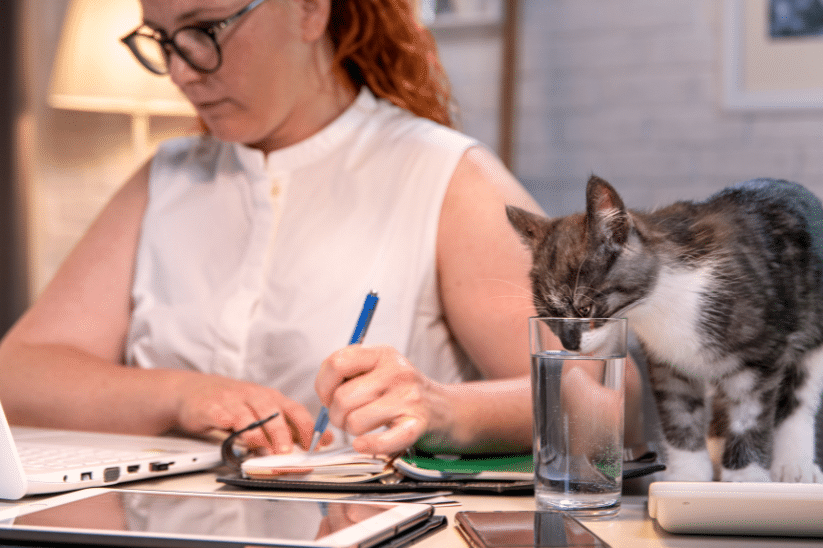Keeping Your Cat Hydrated

All living things need water to survive. Supporting a cat’s hydration levels can be tricky. These feline beauties aren’t natural water sippers. Let’s take a look at your cat’s water needs and how you can help to keep your cat hydrated.
Your Cat’s Water Needs
In the wild, cats derive most of their hydration from hunted prey. Cats are obligate carnivores, meaning they are designed to hunt and feed on smaller animals. They thrive on this kind of high animal protein and fat diet, which also provides hydration. It makes sense that drinking water like, say, a dog doesn’t come naturally to cats. But they are smart, and for the most part will figure out drinking water from a bowl. Or a puddle. Or from your glass when you’re not looking.
Cats need about 50mL of water per kilo of body weight each day. As with any living creature, this amount varies according to individual body function and health, ambient and body temperature, and the type of food they eat.
Causes of Dehydration
There are two ways a cat becomes dehydrated; not enough water coming in, or too much going out. There are a few reasons why this can happen.
Heat. Cats aren’t sweaty creatures. Rather than all-over body perspiration, they sweat through just a few small areas, like their paw pads and nose. How do cats cool themselves down on hot days? Through their saliva. Self-grooming is calming, and it’s also cooling in a similar way to sweating. As the saliva heats, it evaporates and cools down the body.
It follows that active cats, those with thick coats or a naturally warmer body temperature, and those that live in warm homes or hot climates will self groom more than their cooler counterparts, thereby losing hydration through their saliva.
Health. Different health conditions and illnesses affect hydration levels in cats. Digestive variance, general or acute looser stools affect hydration. Cats with diseases such as diabetes or illnesses that cause vomiting and diarrhoea will need more water. Cats that eat dry food will need significantly more water.
Preference. Some cats either don’t like drinking plain water, or don’t drink enough. Read on for how to encourage cats to drink more.
How to Tell if Your Cat is Dehydrated
Panting and lethargy accompanied by distress are signs of dehydration. Look out for loss of appetite or an untouched water bowl.
Check your cat’s skin turgor. Pull up and gently pinch a fold of skin between the shoulder blades. If the skin doesn’t fall straight back into place, your cat is likely dehydrated. The longer it takes for the pinch to return to normal, the more dehydrated they are.
Severely dehydrated cats need to see the vet for oral, injected or IV rehydration. Dehydration left unchecked will begin to affect a cat’s organs, starting with the kidneys and liver.
How to Encourage Cats to Drink More Water
Provide more than one bowl of clean, fresh water. As well as next to their food bowl, keep an extra bowl near their favourite snoozing patch, and in the living area where you or the family congregate.
Do they like licking water dripping from a tap? Try a water aerator made for cats. In-built filters help keep the water clear.
Encourage them to eat wet food or a watery puree designed for cats. Be careful of meat stocks for humans; these can be high in sodium, which can cause issues with cats’ kidneys. Human grade stocks also contain garlic and onion, which are toxic for cats.
Why They Don’t Like Drinking Water
A 2021 study conducted in the US shows that cats increased their fluid intake by 14% if it was higher in viscosity. This means that cats will drink more water if it is even slightly thicker. The added benefit of this greater fluid intake was the decreased formation of kidney stones, which cats that eat dry food are prone to.
One explanation for this is the cat’s tongue. Rather than smooth and velvety in texture like our own, a cat’s tongue is covered with little spines called papillae. The papillae are angled backwards, away from the mouth, which is how they manage to keep themselves well groomed. Researchers believe that the papillae trap more of the slightly thicker liquid, increasing the volume of water ingested.
One way to take advantage of this study’s findings is to add a little clean water to your cat’s wet food. Mixed in with their meal’s gravy, water is more easily consumed. Some cats will eat dry food soaked in water, which is worth trying if your cat is a dedicated dry-food eater.
If all fails, make an appointment with your vet for advice.
The Final Word
There are many reasons a cat becomes dehydrated. Health and living conditions along with a cat’s preference of fluid intake play a part in their hydration. As always, when in doubt, please see your vet for advice and treatment.


